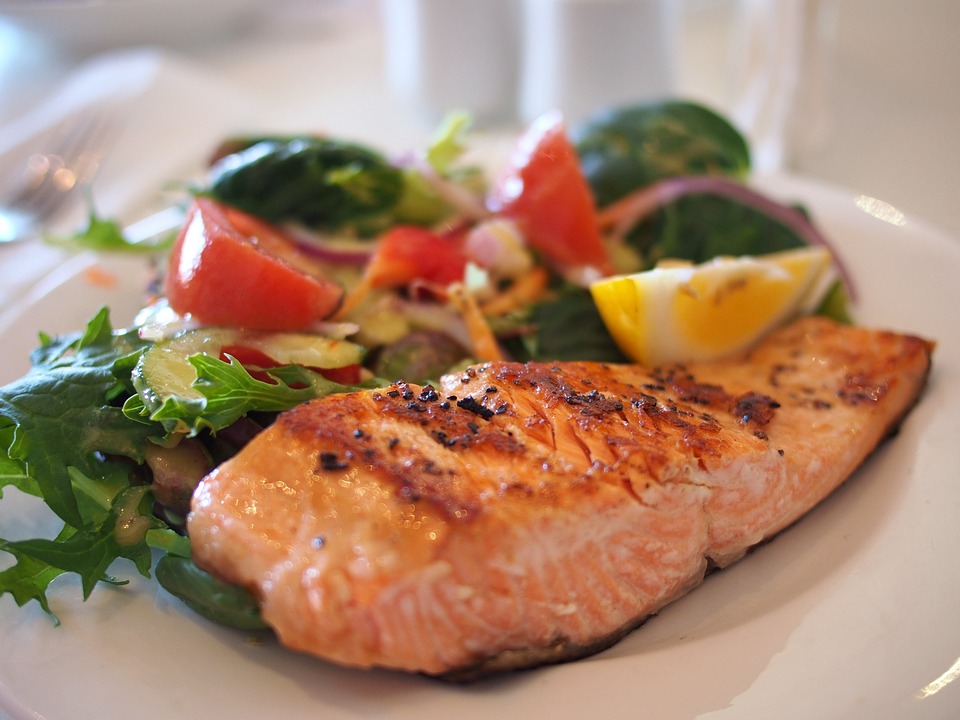By Sarah LeVesque, Recent Arizona State University Nutrition Student
If salmon hasn’t been filling your plate, it might be time to pick some up your next trip to the grocery store. If you haven’t heard, salmon is one of the most nutrient dense foods. It’s a fatty fish that contains high-quality protein and an abundance of vitamins and minerals. Salmon is popular in sushi and sashimi, can be added to a salad, or placed in tacos. I’ve even seen salmon burgers!
The American Heart Association recommends eating fish at least two times a week.

Omega-3 Fatty Acids
The nutrients in salmon have been studied for their ability to reduce the risk for diseases, lower blood pressure, and reduce inflammation. Salmon has been known for its omega-3 fatty acids. Omega-3 fatty acids aren’t ones our bodies can produce. We must obtain it from our diets and are found in fish, other seafood, some plants, and in nut oils. Omega-3 fatty acids promote normal growth, development, and function of our brains.
One of the best sources of omega-3 fatty acids eicosapentaenoic acid (EPA) and docosahexaenoic acid (DHA) is salmon. DHA is a part of every cell in our bodies. DHA important for our brains and during pregnancy. Research suggests that infants whose mothers took supplements with DHA had higher mental processing scores, psychomotor development, and hand-eye coordination by age 4. EPA also supports a healthy heart and improve circulation. It’s also a common treatment for tenderness and stiffness of the joints and is a staple component for our brain cells.
It’s important for mothers to be and new mothers to continue to incorporate foods high in omega-3’s into their diets and their children’s diets since most of the brain growth in children is completed by 5-6 years. Omega-3’s have also been linked in the prevention of attention deficit hyperactivity disorder (ADHD). Filling your plate with salmon a couple times a week can support our brains.
Omega-3 fatty acids help reduce the risk for cardiovascular diseases by stabilizing the heart muscles. EPA and DHA can lower blood pressure because of its capability to dilate the small arteries. The two omega-3 fatty acids that are found in salmon can help our hearts function better and lower blood pressure. Whether your fish is farmed or fresh, they’ll contain these essential fats.
Protein
Salmon is a great source of high-quality protein. A 3.5 ounce serving of salmon contains about 23 grams of protein. Protein has many functions in our bodies. Eating protein is important for body weight loss and maintenance. Body weight reduction is attributed to the ability of protein to keep us fuller, longer. Protein also helps keep our bones stronger. Many studies have suggested protein and calcium work together to keep our bones strong. Consuming protein by incorporating salmon doesn’t just keep us full and lower body fat but it also helps to keep our bones strong, it also supports wound healing.
B Vitamins
Our bodies require B vitamin for energy production, to protect our heart and brain health, and help control inflammation. The B Vitamins found in salmon are important and involved in many functions and processes of our bodies. They help turn the food we eat into energy. The B vitamins also help synthesize and repair DNA. They’ve also been known to lower the risk of heart disease by reducing inflammation. The vitamin B’s found in salmon are also known for their maintenance of brain function and our nervous system functions.
In a 3.5 ounce serving of wild salmon, it contains vitamins B1, B2, B3, B5, B6, B9 and B12 .
Thiamin (B1): 18% DV
Riboflavin (B2): 29% DV
Niacin (B3): 50% DV
Pantothenic acid (B5): 19% DV
Vitamin B6: 47%
Folic Acid (B9): 7% DV
Vitamin B12: 51%
Potassium
Salmon provides 11–18% of our daily value in potassium. We often associate potassium with bananas (10% DV of Potassium), but salmon, fresh or farmed, contains more. Potassium is important in our diets because it’s studied abilities to control blood pressure, reduce the risk of stroke, and protect against heart disease. Consuming salmon reduces the levels of omega-6, and increases the levels of omega-3’s. An imbalance of these omegas can increase inflammation, so consuming salmon may help lower your risk for cardiovascular diseases.
If these reasons aren’t convincing enough to get you to fill your plate with salmon, I don’t know what will. It can be affordable and easy to make. I always buy it the same day, double check the dates and trust my judgment on what the filet might look like. Picking it up the same day that I am going to cook it saves me money because grocery stores usually offer discounts for those items.
One of my favorite ways to make salmon contains only a few ingredients: olive oil, lemon, pepper, and a little chili. I usually bake it in the oven at 435 degrees Fahrenheit for about 12 minutes or until it’s flaky. You can check the internal cooking temperature and ensure it’s reached 145 degrees Fahrenheit. I love pairing it with greens, and I recently tried it with bok choy, farro, and garlic!


3 Responses to Fill Your Plate with Salmon!